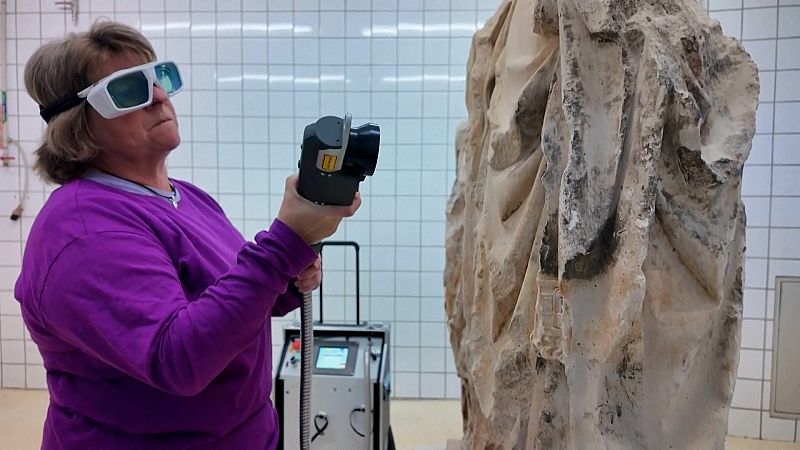Lasers once used for skincare are now helping to restore French art masterpieces

In a quiet wing of Paris’ Louvre gallery, away from the crush of visitors and beneath the glass pyramid, conservators are wielding an unlikely weapon in the battle against centuries of grime: dermatology lasers.
High-precision devices, better known for smoothing wrinkles in clinics around the globe, are now breathing new life into marble, limestone, and ivory at the National Centre for Research and Restoration in French Museums.
Here, hundreds of sculptures - from medieval saints to Renaissance masterpieces - sit in various stages of repair. The lasers, funded by the French cosmetics giant L’Oréal, make the job faster, safer, and more exact.
“It’s absolutely fascinating to see how these two lasers - used to improve the appearance of stone - are also used in dermatology to improve the skin’s aspect. Both lasers are complementary; they operate at different wavelengths, targeting different chromophores or using heat in different ways," said Delphine Kerob, a dermatologist and scientific director of La Roche-Posay at L’Oréal.
"One laser is ablative, the other is non-ablative, so they each have different benefits but also different side effects. Care is therefore very important - on the skin, and here on the stone - to make sure the treatment isn’t too ablative,” she added.
"It's a lifesaver in fact for us"
Among the works undergoing this high-tech treatment is a 16th-century Ecce Homo sculpture, which has been darkened by centuries of pollution and past restoration attempts. Over three months of meticulous cleaning, conservators have managed to uncover traces of its original colour beneath the soot.
"Many pieces we have to restore were displayed outdoors and have black crust or thick grime on the surface. And sometimes, the limestone is more fragile than the black crusts. And we have to find a way to clean them up without damaging the original material," said Curator Laetitia Barragué-Zouita.
"And a laser, which has only a thermal and a mechanical action, helps us not to damage the original surface. So it's a lifesaver in fact for us”.
Four specialised lasers are now in use at the laboratory: the Eos Combo, two Er: YAG (Erbium) lasers, and the Infinito. All are made by the Italian company El. En (Electronic Engineering) and each is tailored to a specific restoration challenge.
For example, the Infinito can handle larger, more complex surfaces thanks to its adjustable beam, which can be shaped into squares or rectangles to follow the contours of a sculpture.
The Eos Combo laser is versatile enough to work on both organic and inorganic materials, from stone and ivory to fragile wooden marquetry. Meanwhile, the Er: YAGv is the tool of choice for gilded or painted surfaces where even the lightest abrasion could cause damage.
Both art and skin, notes Kerob, suffer under the same environmental pressures -pollution, UV light, humidity, and time.
"This is why it is very important to choose the right device with the right issue and with the right parameters also on the device and make sure we will treat the issue but not harm the skin or the piece of work," she said.
However, lasers are not suitable for every piece. Of the 30 sculptures currently under restoration, only around a third will receive laser treatment. Others require traditional chemical or mechanical cleaning.
Today

